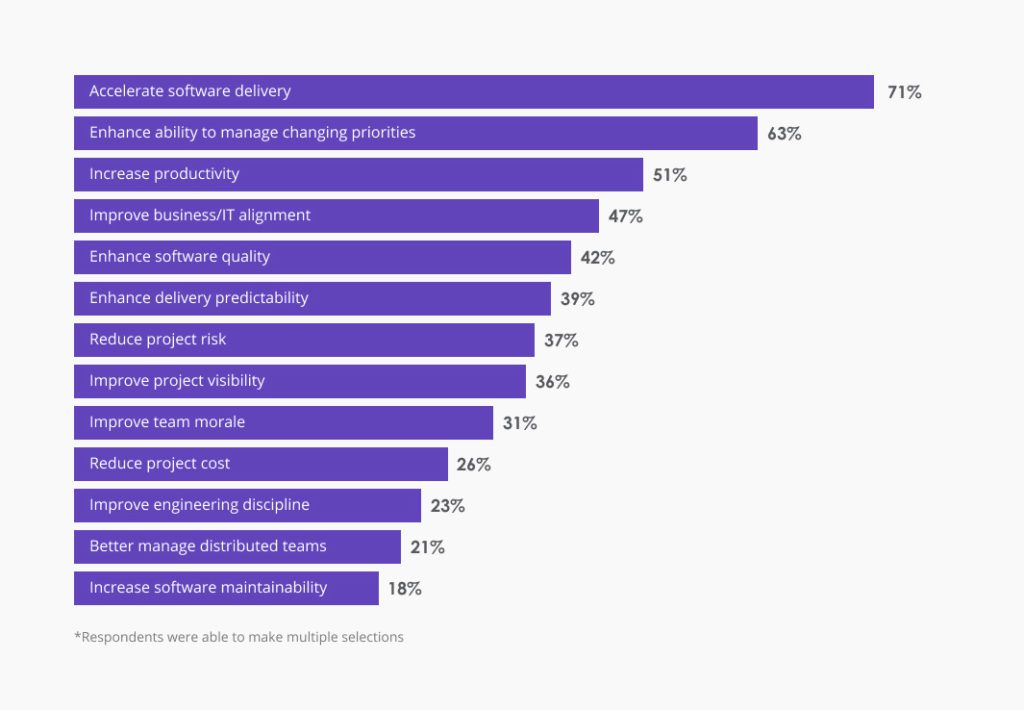Software Development Methodologies: 4 Core Options

Software delivery is a complex multi-step process. How you structure and manage those steps determines the end product quality, project timelines, and workforce efficiency.
Businesses can organize the engineering process using different types of software development methodologies. These models provide development teams with a framework for structuring SDLC, defining KPIs, monitoring progress — and, in the end, delivering high-quality software.
But more isn’t always the merrier when making complex decisions. If you test popular software development methodologies, you may find that one leads to better results for your specific project than another.
Avoid the trial-and-error process and make an informed decision early on. From this deep dive, learn which model is best for your software development project.
What is a Software Development Methodology?
Software development methodologies (or software development models) are approaches to planning, structuring, and managing software development and delivery.
Think of a software development methodology (SDM) as a rulebook of guidelines and principles for organizing each step in the software development life cycle (SDLC), from requirements gathering and analysis to release.
Should the project unfold linearly or in small incremental cycles? Should your teams stick to a greater plan, or can they adapt to changing conditions during the pre-planned work cycles? Do you check KPIs throughout the project development or at the end of production?
Your selected software development methodology will help you answer all those questions.
In terms of team synergy, software development methodology helps ensure that all team members are on the same page about the following questions:
- In the current version, what features do we plan?
- How is software development handled? Who is responsible for what?
- What is the release date for the software?
- What type of testing should we do and when?
A well-implemented SDM helps your team make better estimates, commit to deadlines, identify potential problems beforehand, minimize reworks, and release high-performing software.
The 4 Main Types of Software Development Methodologies
Agile and Waterfall are the two classic software development methodologies. Their principles are so integral that many complementary software development models have emerged based on them.
In our post, we’ll discuss four main types of software development methodologies:
- Waterfall
- Agile
- Extreme Programming Methodology (XP)
- Rapid Application Development (RAD) Model
Waterfall Methodology
Waterfall methodology assumes a linear, sequential approach to software development. There is no overlap between the stages since the next one begins after the previous one is complete. The deliverables of each stage are also different.
Here’s how the Waterfall SDLC process looks from a structural perspective:
Benefits of the Waterfall model:
- Easy adaptation: Even people unfamiliar with the principle of Waterfall will quickly grasp the basics due to its linear phase structure.
- Process consistency: The team completes one phase at a time without overlap. Thus, Project Managers can track, evaluate, and report the work without much hassle.
- Clean vision: A Waterfall model emphasizes the importance of advanced planning, which helps envision the outcome.
- Decreased dependency on stakeholders: Product Owners are primarily involved in requirements gathering and planning and less during other stages.
Shortcomings of the Waterfall model:
- Lack of flexibility: The Waterfall model leaves little room to address unexpected issues and changes, so the team cannot respond fast to shifts in priorities.
- Later delivery of working code: It takes more preparation to begin coding.
- Reliance on early requirements: It can be difficult to define all requirements initially for large projects. So, teams will need to base some of the requirements on their assumptions.
- Lack of client feedback: The reduction in stakeholder input could result in unmet expectations and vague requirements.
Agile Methodology
Agile is a software development methodology based on an iterative approach. The core idea of Agile is to establish cross-functional teams that tackle the larger project in small increments (Sprints). Such an approach allows teams to continuously evaluate requirements, plans, and results during each iteration. As a result, they can respond to changes faster.
Here is how an Agile development life cycle looks:
What Does It Mean to Be Agile?
Agile is more than a methodology; it’s a mindset shift. Agile companies adhere to the following principles:
- Individuals and interactions over processes and tools
- Working software over comprehensive documentation
- Customer collaboration over contract negotiation
- Responding to change instead of following a plan
Additionally, according to McKinsey’s report, Agile businesses follow the same mindset in managing their strategy, structure, process, people, and technology.
- Agile processes ensure rapid decisions and learning cycles, allowing the teams to embrace uncertainty and adapt to changing conditions.
- Agile people are self-driven individuals, taking full ownership of every decision and driving the team, company, and client to meet expectations.
- Agile technologies will change the game by evolving into next-generation enabling technologies, delivery practices, tools, and systems.
As you can see, Agile extends beyond software development methodology. It’s a shift in operational strategy that helps realign people, processes, and technology around the vital goal — driving value for end-users. In fact, McKinsey’s research also showed that Agile enterprise could improve employee engagement scores by 20–30 points.
Here are more reasons why in 95% of companies at least one team is using Agile.
Benefits of the Agile model:
- Increased customer satisfaction: 62% of companies saw improvements in customer satisfaction after switching to Agile.
- Better product quality: Agile practices (such as sprint retrospectives, a clear definition of what is done, and the use of automation tools) contribute to high-quality software development.
- More relevant metrics: Compared to traditional teams, Agile teams typically use more accurate and appropriate metrics to estimate time and cost, evaluate performance, and make decisions.
- Financial efficiency: Per HBR & Atlassian study, Agile reduces costs by 7-29%.
- Faster time-to-market: The same research also indicates that Agile companies improve software delivery speed by 15-20%.
- Better operational performance: As per McKinsey research, companies adopting Agile saw 30%-50% improvements in operating performance.
Shortcomings of the Agile model:
- Operational maturity. Agile requires investment in new processes, supporting tools, and cultural shifts. This may be hard to achieve for teams with a low development culture.
- Dependency on user feedback: Agile requires constant collaboration and frequent communication between Software Developers and users (or Product Owners as representatives of the latter).
- Some cultural reluctance: Many companies still prefer more traditional methodologies over Agile, so they adopt it slowly or don’t adopt it at all.
- Failure to fully commit to Agile. Some companies cherry-pick a few Agile practices, introduce them into their project management, and fail because of this limited commitment.
Why Transition to Agile from Waterfall
As per the 2020 State of Agile Report, 6% of businesses are considering adopting Agile, 54% are still maturing in their Agile practices, and 20% are experimenting with this methodology in some aspects.
The following are the primary reasons companies try to adopt Agile or strive to attain higher maturity levels:

Source: State of Agile Report
Agile often goes hand in hand with outsourcing. Why? It improves the onboarding of external partners, whether we talk about several people or an entire Dedicated Team.
From the above chart, you can see that 21% of companies adopt this methodology to improve the management of distributed teams. This aspect makes Agile applicable to outsourcing: you can incorporate a cross-functional team as your Agile squad! Due to Agile’s flexibility, it is easier to scale up teams in the middle of the project (which is not possible with Waterfall).
Extreme Programming Methodology (XP)
The extreme programming (XP) approach is a variation of Agile that involves frequent updates and short development cycles, allowing Software Developers to respond quickly to changing requirements.
As the name implies, XP takes development practices to “extreme” levels, aiming to produce high-quality software very quickly. One of the distinguishing features of XP is its strict rules that extreme programmers follow when planning, managing, designing, coding, and testing.
Rapid feedback is one of the values of Extreme Programming. Here is the XP feedback cycle:
Extreme programming makes the most sense for projects with dynamically changing requirements and constant utilization of unit and functional tests. To work effectively, XP must be supported by a small, co-located development team. The presence of customers who can identify and validate user needs is also crucial for success.
Benefits of Extreme Programming
- Rapid feedback: Software Developers are always aware of when something is amiss or right and react accordingly. No bug is left unresolved if noticed.
- Well-placed priorities: The team focuses on the most critical tasks.
- Assertive communication: Extreme programmers constantly communicate with customers, other Software Developers, and stakeholders.
- Flexibility under tight deadlines: The XP programmers launch projects as soon as possible and make the changes the customer requests.
Shortcomings of Extreme Programming:
- Code over strategy: Emphasizing code more than design distorts business strategy.
- Too strict rules: Some XP rules are not easy to follow (e.g., the customer may not always be available, programmers may not be able to conduct production code in pairs, etc).
- Remote unfriendliness: XP is most appropriate for in-house teams, and its effectiveness diminishes when working from home or outsourcing.
- Dependency on self-discipline: XP mainly depends on the programmers’ sense of responsibility when they follow all the rules (daily stand-ups, rapid integration, etc.).
Rapid Application Development (RAD) Model
Rapid application development (RAD) is another variation of Agile that emphasizes rapid prototyping over planning. RAD ensures a quicker delivery of a minimal viable product (MVP) by creating the functional modules in parallel and meshing them into prototypes.
The lack of a pre-planned backlog makes incorporating changes into the development process more manageable. With RAD, you arrive at a final product through an interaction of prototypes.
It’s possible to do RAD when a system can be modularized and delivered incrementally. Other main requirements for implementing this methodology are the high availability of Designers for prototyping, the use of automated code-generating tools, and significant input from domain experts with relevant business knowledge.
Benefits of rapid application development
- Reduced delivery time: RAD provides quick planning, testing, and prototyping, allowing faster time-to-market.
- Users’ feedback: Customers constantly interact with evolving prototypes so the application can gradually fit the target audience’s needs.
- Time-efficiency: Using automated tools for development and testing is the main requirement of RAD.
- Risk mitigation: The prototyping methodology emphasizes the early identification of the risks.
Shortcomings of Rapid Application Development
- The strong need for experts: The success of RAD depends on employing highly qualified professionals.
- Dependency on users: RAD relies on user feedback. There is a great chance of failure if you don’t have access to user feedback or if customers do not know what they want.
- Lack of scalability: RAD works better with small to medium-sized projects.
- Poor design: Prototyping structure may encourage Software Developers to ignore the system architecture issue instead of trying to update individual components.
To Conclude
Each software methodology has its advantages depending on the project type. Short-term projects can use Waterfall or Rapid Application Development, while Agile may fit every size project, but its real value is in ongoing product development.
Agile is sometimes regarded as a buzzword, especially among people who don’t really use it. Yet, it is not only a powerful project management tool but also a strong mindset of growth. When done right, Agile allows your business to move faster and react to dynamic customer needs. Speed and relevance: isn’t that what we need in the 2020s?
Are you interested in moving to Agile but not sure where to start? Contact us to schedule a workshop!






